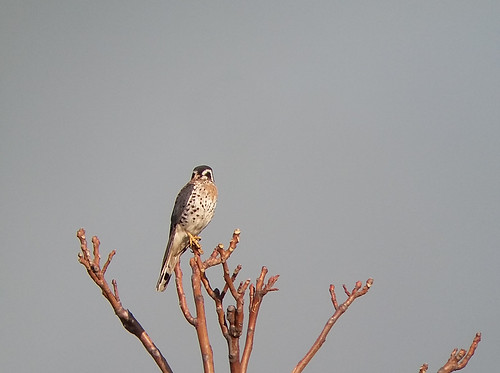Like stork nests and eagle aeries, the huge stick condominiums built by monk parakeets offer nooks and deep crannies for other creatures to live in, too. I shudder slightly to imagine just what creepy crawlies must be crawling creepily around in there, but vertebrates also take advantage of the shelter these elaborate structures provide for roosting and nesting.
Here in northern New Jersey, I’ve twice seen wintering American kestrels perched atop parrot nests at a suspiciously early hour, making me wonder whether the cold-sensitive little falcons had perhaps spent the night inside — a phenomenon widely known from South America and recently documented in Florida.
And of course, there is scarcely a parakeet nest anywhere in the species’ wide introduced range that does not host a pair or two or ten of house sparrows year-round.
What I really want to see, though, and someday I shall, is ducks cozily at home in one of the dark crevices in the monk parakeet’s abode.
William Henry Hudson reported that
a species of Teal (probably Querquedula brasiliensis) also sometimes occupies and breeds in their chambers,
an observation fleshed out at the turn of the twentieth century by the collector of Andean birds Demetrio Rodríguez and the Buenos Aires museum preparator Antonio Pozzi.
Rodríguez and Pozzi found that the ducks, notwithstanding their hosts’ “combative and boisterous” nature, laid their eggs both in unoccupied chambers and in cavities that already contained parakeet eggs; in the latter case, “confronted by eggs so much more voluminous than their own,” the nonplussed parakeets abandoned the clutch and started over in a different apartment. The duck, finding herself mistress of the manor, crushes the parrot eggs and settles in to incubate, cushioning the floor beneath her eggs with feathers plucked from her breast.
How, though, do the ducklings get from their exalted nest site to water, often some miles distant? Rodríguez found it implausible that they should jump to the ground: if the fall did not kill them, they still would not be able to follow their parents all that distance to the nearest lake or pond. He suggested instead that the mother carried the young in her bill to the ground beneath the nest, one by one, and then carry them to water. A more recent study doesn’t answer the question, but my guess is that teal babies bounce just like wood ducks or merganser ducklings, with nothing more than encouragement needed from their parents.
Rodríguez and Pozzi’s field work was reported by Robert Dabbene, who added a query of his own:
it would be very interesting to know how the female duck would behave if she happened not to break the parrot eggs already in the nest she took over and incubated them instead with her own. Parrots, unlike ducks, are nidicolous, that is to say, the chicks remain in the nest for considerable time, when they are fed by their parents; thus, [should they be incubated and hatched by a duck] the chicks would starve when the duck and her ducklings abandoned the nest, or what I believe would be even worse, would drown if the duck carried them to water together with her ducklings.
Seems unlikely. But fascinating all the same.





